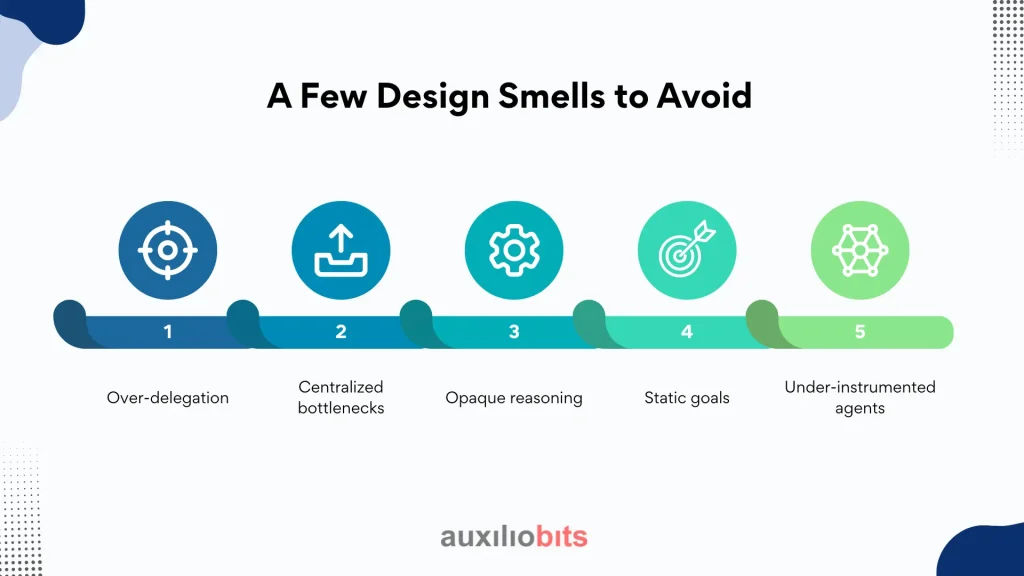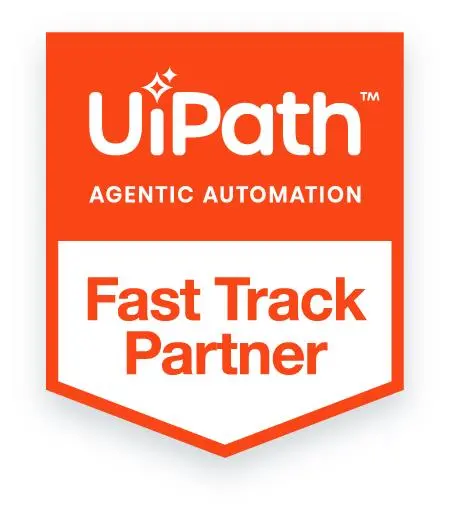
Key Takeaways
- Agentic design patterns are the new enterprise architecture language. They translate the chaos of multi-agent coordination into scalable, accountable structures that corporate IT can trust and evolve.
- The right pattern depends on the degree of autonomy and risk tolerance. Use orchestration where control is vital, swarms where adaptability matters, and federated meshes where silos need collaboration without centralization.
- Governance is the real differentiator. The most successful enterprises don’t just deploy intelligent agents—they build meta-agents, watchers, and digital twins to supervise, test, and align them with compliance and business intent.
- Patterns must evolve with maturity. Early implementations often start with orchestrator–executor or mediator setups, then transition toward goal–plan–execute or federated mesh models as trust and data infrastructure grow.
- Autonomy works only when it’s designed for collaboration. The future of enterprise automation isn’t the smartest individual agent—it’s a well-behaved ecosystem where agents coordinate, negotiate, and adapt together.
Agent-based automation isn’t new. It’s just finally growing up. For years, enterprises relied on static RPA bots that followed rules like dutiful clerks—never improvising, never asking why. Now, we have autonomous agents: goal-driven systems that negotiate, coordinate, and adapt in real time. But with that evolution comes a new challenge—designing these systems so they don’t collapse under their own complexity.
That’s where design patterns come in. Not the UML-diagram kind that architects love to print on t-shirts, but practical, lived-in patterns born from trial, error, and late-night debugging of misbehaving multi-agent workflows.
Let’s walk through the most useful design patterns that shape robust agent-based automation architectures—the ones that actually survive inside large, regulated, politically complicated enterprises.
Also read: Designing a maturity model for agentic process automation adoption
Design patterns that shape robust agent-based automation architectures
1. The Orchestrator–Executor Pattern
In any complex enterprise, automation tasks range from “reset a password” to “run a full compliance audit.” One agent can’t possibly handle both. The Orchestrator–Executor pattern introduces a control hierarchy—not too rigid, but structured enough to avoid entropy.
- Orchestrator Agent: Think of this as a project manager. It doesn’t do the work but knows who should. It plans, delegates, monitors, and resolves conflicts between task-specific agents.
- Executor Agents: These are the specialists—focused, narrow-purpose entities handling discrete activities like document validation, SAP posting, or risk flagging.
Why it works:
- Enterprises love accountability. This pattern creates traceable lines of responsibility.
- It scales gracefully—you can add new executor agents without touching the orchestrator logic.
- Failures are contained. If one executor crashes, the orchestrator can reassign the task or retry later.
Where it fails:
- Orchestrators become bottlenecks if overburdened with logic.
- Cross-agent communication latency can create micro-delays that add up, especially in real-time processes (like claims adjudication).
2. The Percept–Decide–Act Loop Pattern
At the core of every intelligent agent lies a feedback loop: it perceives, decides, and acts. The elegance of this pattern lies in its simplicity, but the nuance lies in what it perceives and how it decides.
In enterprise automation, this loop manifests as:
- Perception Layer: Collect signals—from emails, databases, or ERP logs.
- Decision Layer: Use reasoning or LLMs to determine the next action.
- Action Layer: Trigger an automation, send a message, or update a record.
Why it matters:
- Without perception, your automation is blind. Without decision-making, it’s brain-dead.
- It allows adaptability — agents can react to unexpected inputs instead of crashing on “invalid format” errors.
Subtle nuance: Enterprises often over-engineer perception. They pour resources into perfect data ingestion, when often the smarter investment is in contextual decision logic. A slightly noisy input stream is fine if your decision model can tolerate ambiguity.
This pattern shines in customer service automation, where perception is messy—free-form text, attachments, and tone. One banking client used this design to triage complaints: a perceptual agent interpreted email tone and keywords, then a decision agent chose whether to escalate or auto-respond. Imperfect? Yes. But human supervisors said they trusted it more than the old keyword-based routing bot.
3. The Blackboard Collaboration Pattern
When multiple agents work on the same problem, coordination becomes the monster under the bed. You can’t have every agent talking to every other agent — the network overhead would drown you.
The blackboard pattern fixes this elegantly.
Imagine a shared digital noticeboard. Agents post their findings, partial results, or hypotheses. Others pick up where they can add value.Example: In a fraud detection system, one agent posts a transaction pattern flagged as suspicious. Another adds historical data. A third, equipped with a reasoning model, evaluates risk confidence. Finally, a supervisor agent approves escalation.
Advantages:
- Decentralized intelligence. Agents don’t need to know each other; they only need to know the board.
- Perfect for asynchronous work—one agent can post at night, and another can pick it up in the morning.
Pitfalls:
- Versioning hell. Without strict data governance, the “board” can turn into a junk drawer.
- Requires careful design of posting rules and access privileges, especially in regulated environments (e.g., SOX, HIPAA).
4. The Mediator Pattern
In the early days of multi-agent systems, engineers naïvely let agents communicate directly. Then came deadlocks, circular dependencies, and duplicated efforts — basically, diplomatic failure.
Enter the Mediator pattern. A dedicated agent manages all inter-agent communication, enforcing protocols and prioritization.
Why it’s essential in enterprises:
- Corporate processes involve conflicting goals. A finance approval agent might delay a vendor-onboarding agent waiting for compliance clearance. The mediator coordinates such standoffs.
- It reduces complexity—each agent talks to the mediator, not the entire network.
When to avoid it:
- For high-frequency or low-latency tasks. The mediator adds unavoidable overhead.
- When agents are highly independent (e.g., distributed monitoring agents).
5. The Hierarchical Delegation Pattern
When you scale to hundreds of agents—think enterprise-wide automation with HR, finance, and operations agents—flat hierarchies crumble.
In the Hierarchical Delegation model:
- High-level agents set objectives (e.g., “Process all month-end reconciliations”).
- Mid-level agents break them into sub-goals (e.g., “Fetch ledger data” and “Cross-verify invoices”).
- Lower-level agents perform tasks (e.g., “Run matching rule set 3”).
This pattern mirrors human management structures. It’s also psychologically comfortable for corporate IT teams—it feels familiar.
Where it excels:
- Massive-scale automation requiring coordination across silos.
- Processes where rules evolve—changes at the top cascade naturally downward.
Where it gets messy:
- Error propagation. A faulty directive from a top agent can mislead hundreds downstream.
- Debugging becomes a nightmare if you lack transparent audit trails.
Many large banks quietly use this pattern for their regulatory reporting automations — not because it’s elegant, but because it’s survivable in a bureaucracy. Agents mirror departments. Reporting lines are encoded in software. It’s not futuristic, but it works.
6. The Swarm Intelligence Pattern
Now we’re entering the territory where enterprise architects start to sweat. Swarm intelligence—multiple agents cooperating through local interactions without centralized control—is stunning in theory but tricky in practice.
Why it’s compelling:
- Resilience. There’s no single point of failure.
- Adaptability. Agents self-organize around hotspots or anomalies.
Why it scares CIOs:
- Governance nightmares. Who’s accountable if something goes wrong?
- Hard to predict. A swarm doesn’t “decide”—it emerges.
7. The Goal–Plan–Execute Pattern
This pattern, borrowed from cognitive architectures like BDI (Belief–Desire–Intention), fits naturally in enterprise automation that needs reasoning—not just reaction.
An agent here:
- Sets goals: “Ensure customer orders are fulfilled within SLA.”
- Generates plans: “Check inventory → Trigger replenishment → Confirm shipment.”
- Executes actions with continuous feedback from the environment.
Advantages
- Agents can handle partial failures gracefully. If step 2 fails, they can replan dynamically.
- Excellent for semi-structured business processes, like procurement or collections.
But… It’s computationally heavy. Agents must maintain internal models of the world, which requires persistent memory and reasoning capability. In environments like Azure, engineers often distribute this across containers—stateful reasoning on Redis, planning logic via Functions or Logic Apps. When done right, it feels almost human.
8. The Observer–Watcher Pattern
In regulated industries, automation without oversight is a compliance risk waiting to explode. That’s where the Observer–Watcher model steps in.
Each operational agent (say, an invoice processor) is “watched” by a monitoring agent that logs actions, validates outputs, and triggers alerts for anomalies.
Why it’s critical:
- Provides auditability—regulators love immutable logs.
- Enables self-healing—watcher agents can intervene or trigger restarts.
However, beware of alert fatigue. In one finance client, watcher agents were too sensitive, flagging benign anomalies as “critical.” Result: humans ignored them. The team learned to calibrate thresholds, just as SOC analysts tune their SIEM tools.The clever trick? Implement meta-watchers—agents that monitor watcher performance. Yes, recursion. But it’s surprisingly effective for governance.
9. The Digital Twin Agent Pattern
Before granting autonomy in a mission-critical process (like financial forecasting or clinical trials), it’s wise to test agentic behavior in parallel — not in production.
Digital Twin Agents do exactly that. They mirror human workflows, learn patterns, and simulate decisions. Once validated, they can take over incrementally.
Why it’s pragmatic:
- Builds trust among business stakeholders.
- Allows comparative metrics—how close is the agent’s output to human judgment?
Used widely in pharma and banking, this pattern shortens the “AI-to-production” cycle while minimizing risk. One pharma firm used it to model clinical trial data management, running agentic twins alongside humans for six months. When discrepancy rates fell below 2%, they made the switch.
10. The Federated Agent Mesh Pattern
In large organizations, no one owns the “whole” automation landscape. You’ve got finance running UiPath, HR using Workato, IT preferring Azure Logic Apps, and data teams living in Databricks.
The Federated Agent Mesh pattern connects these silos through standardized protocols—often via message buses, APIs, or even MCP-like interoperability layers.
Each domain retains autonomy, but agents can cooperate on cross-domain workflows (e.g., HR hiring triggers IT provisioning).
Why it’s the future:
- It respects local governance while enabling global intelligence.
- Avoids the “one platform to rule them all” fallacy that’s burned many CIOs before.
When done right, it’s invisible—like enterprise nervous tissue. When done poorly, it’s bureaucracy wrapped in APIs
A Few Design Smells to Avoid
Even experienced teams stumble. Watch for these patterns of failure:

- Over-delegation: Too many layers of orchestration slow everything down.
- Centralized bottlenecks: One overworked orchestrator agent kills scalability.
- Opaque reasoning: If no one can explain why an agent made a decision, compliance will eventually intervene.
- Static goals: Agents that never update their goals quickly become irrelevant.
- Under-instrumented agents: Without telemetry, debugging is blindfolded.
The Art of Balance
The hardest part of designing agentic automation isn’t the code. It’s the governance of autonomy. Give agents too little freedom, and you’ve just built expensive RPA. Give them too much, and your process owners start sleeping with one eye open. The sweet spot lies in architectural intent—defining how much intelligence sits at each layer and how much control remains centralized.
The Ending Thoughts
Agent-based automation isn’t about replacing humans. It’s about building digital colleagues that can think, coordinate, and occasionally disagree—productively. And like any good enterprise system, it needs structure. These patterns aren’t commandments, but they’re guardrails.
Because at the end of the day, it’s not the smartest agent that wins. It’s the one that plays well with others.








